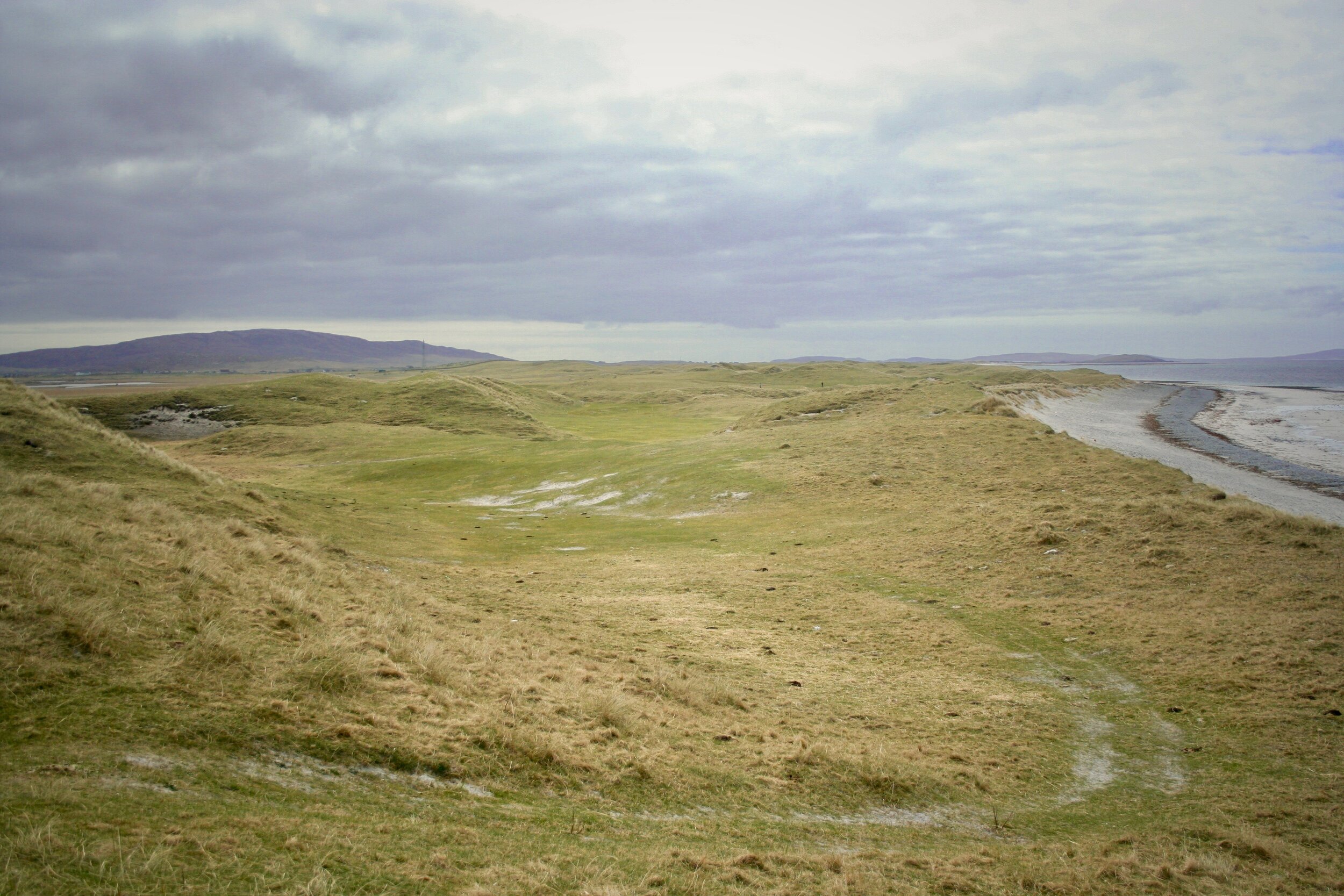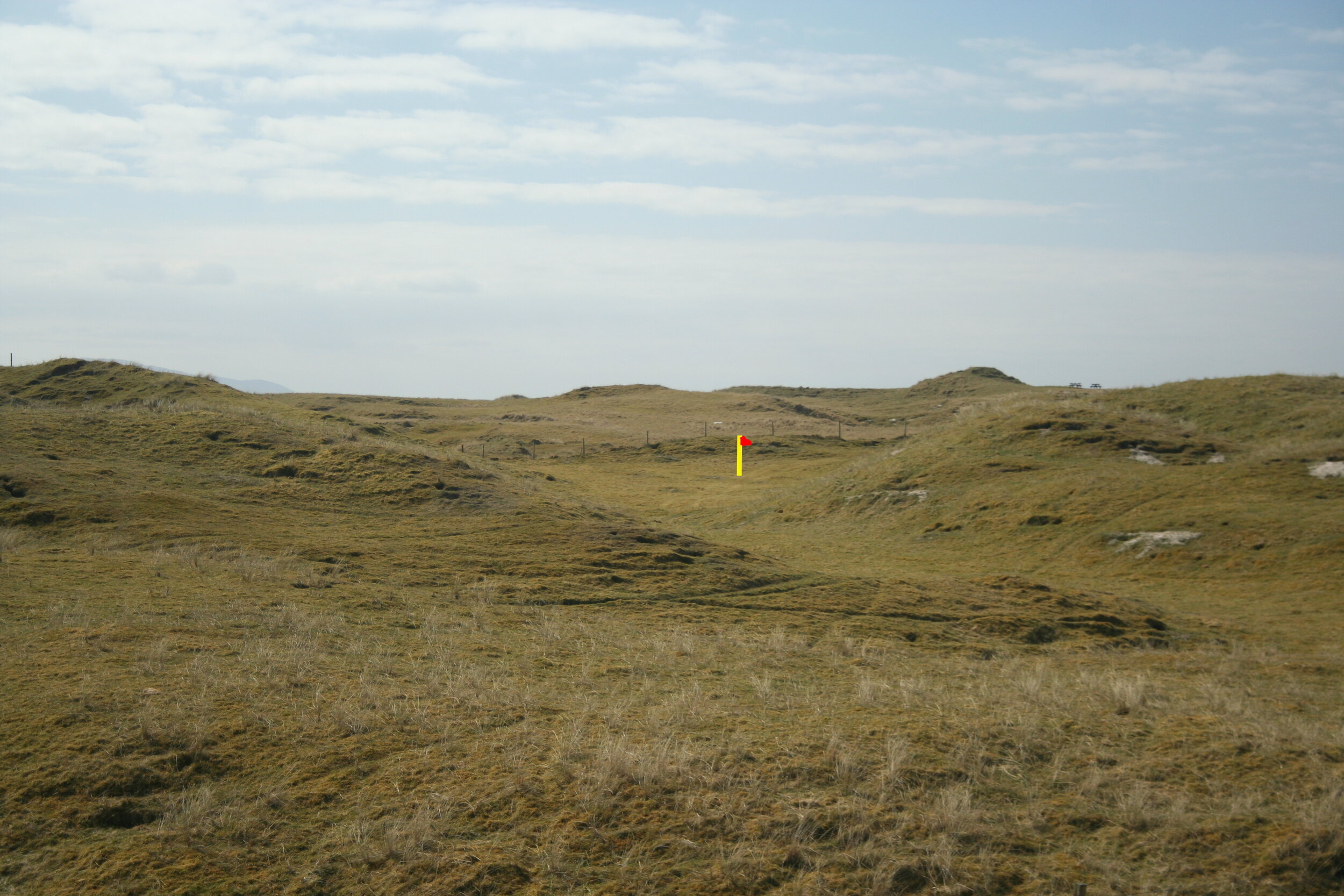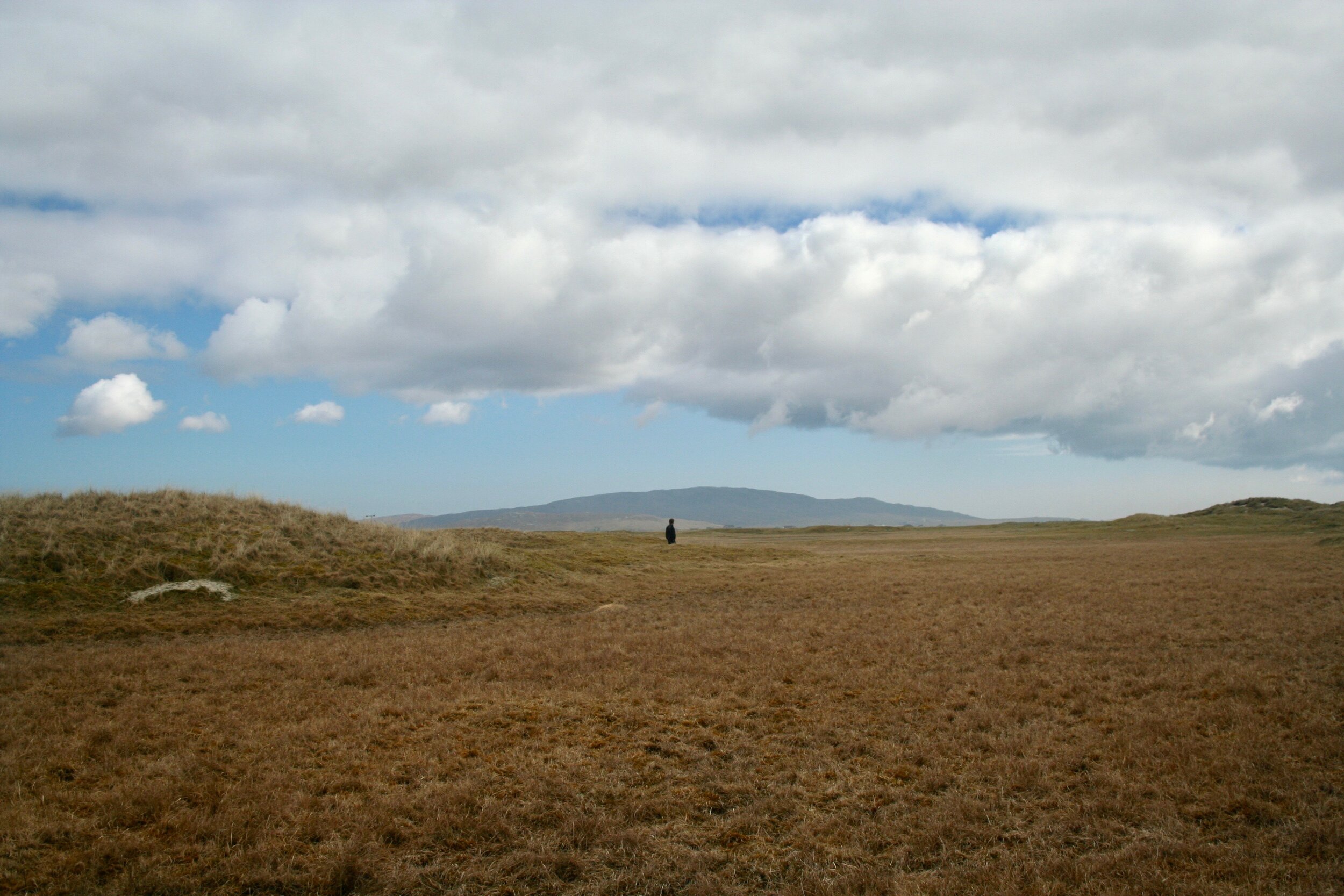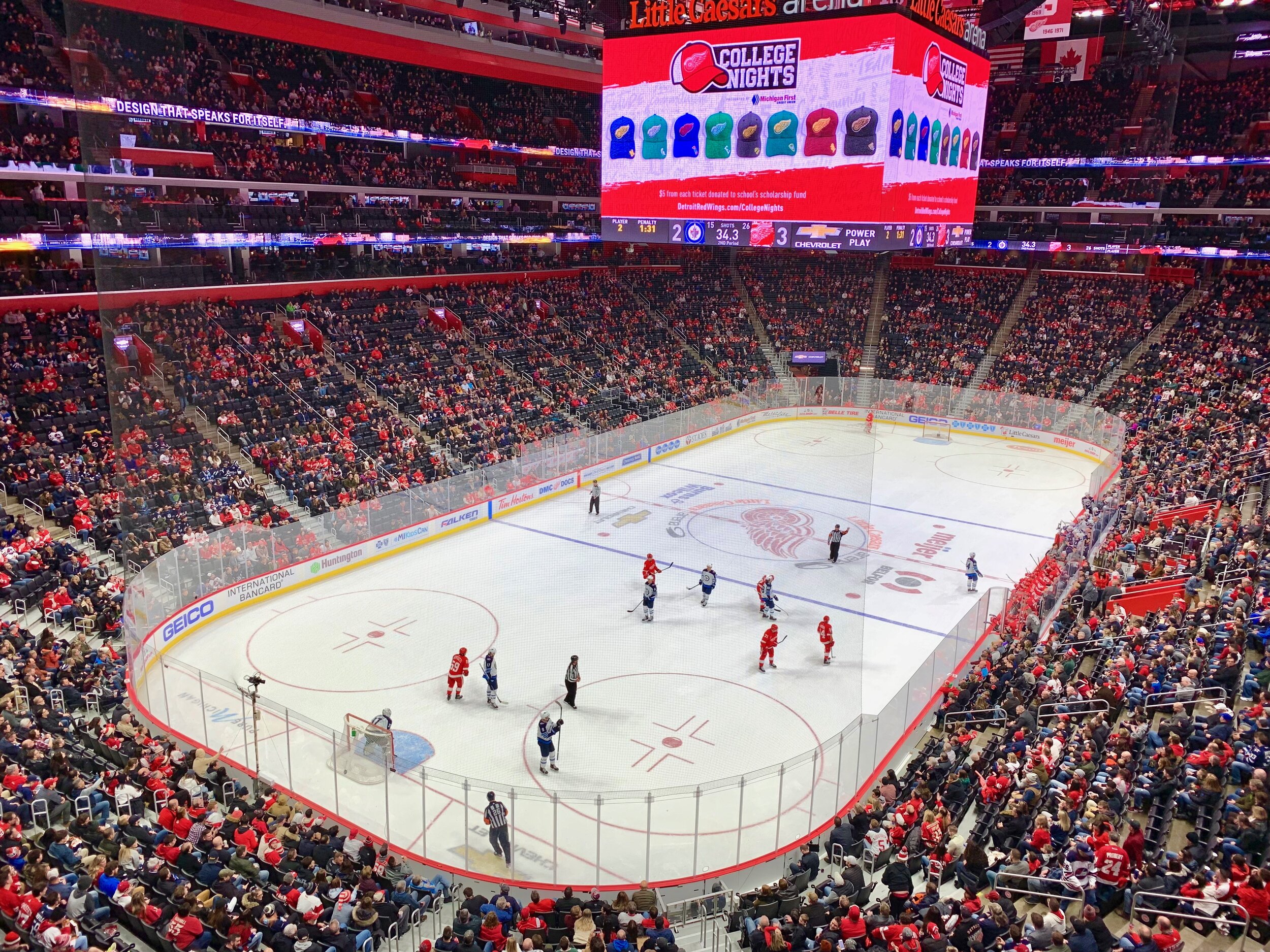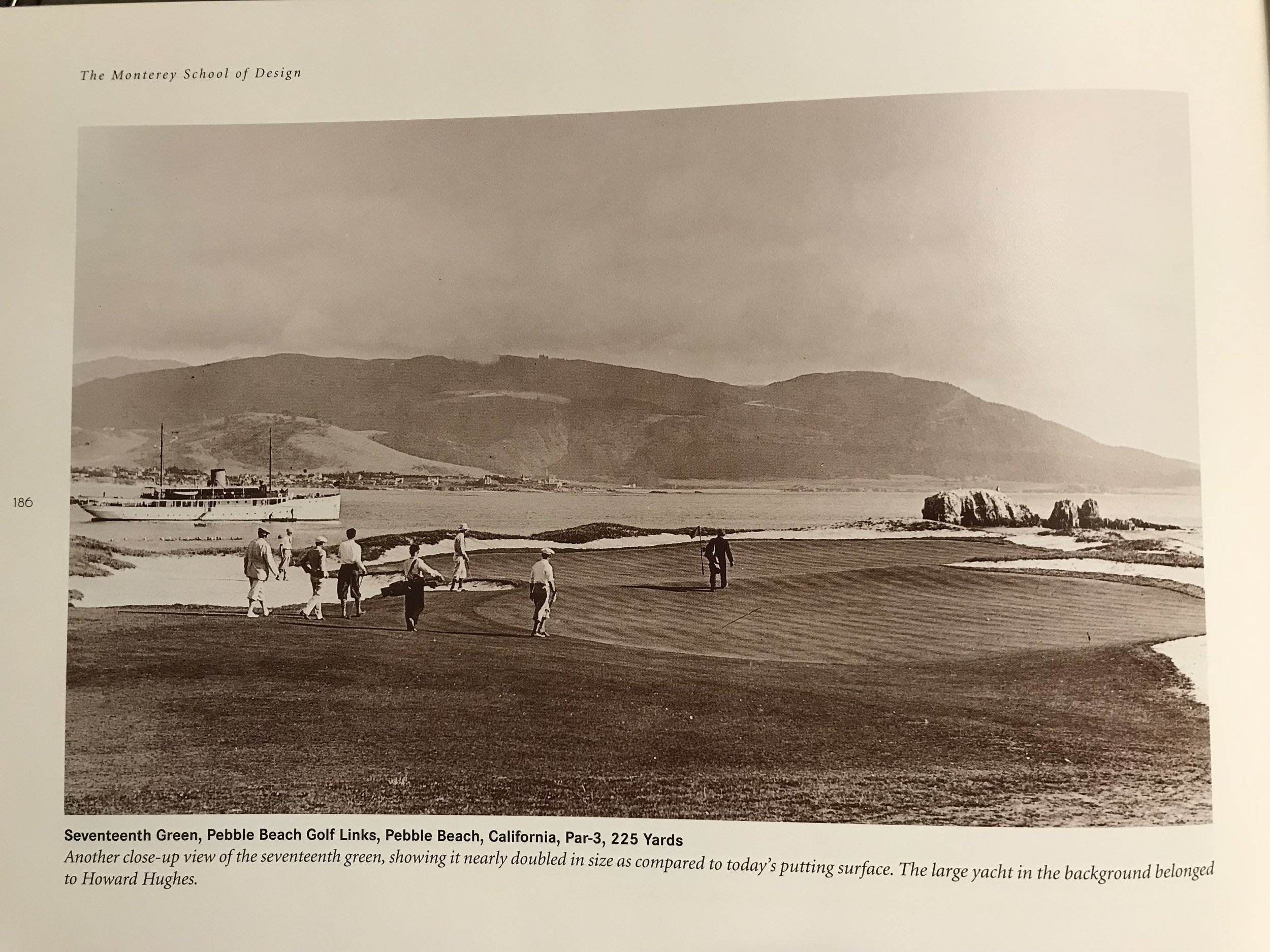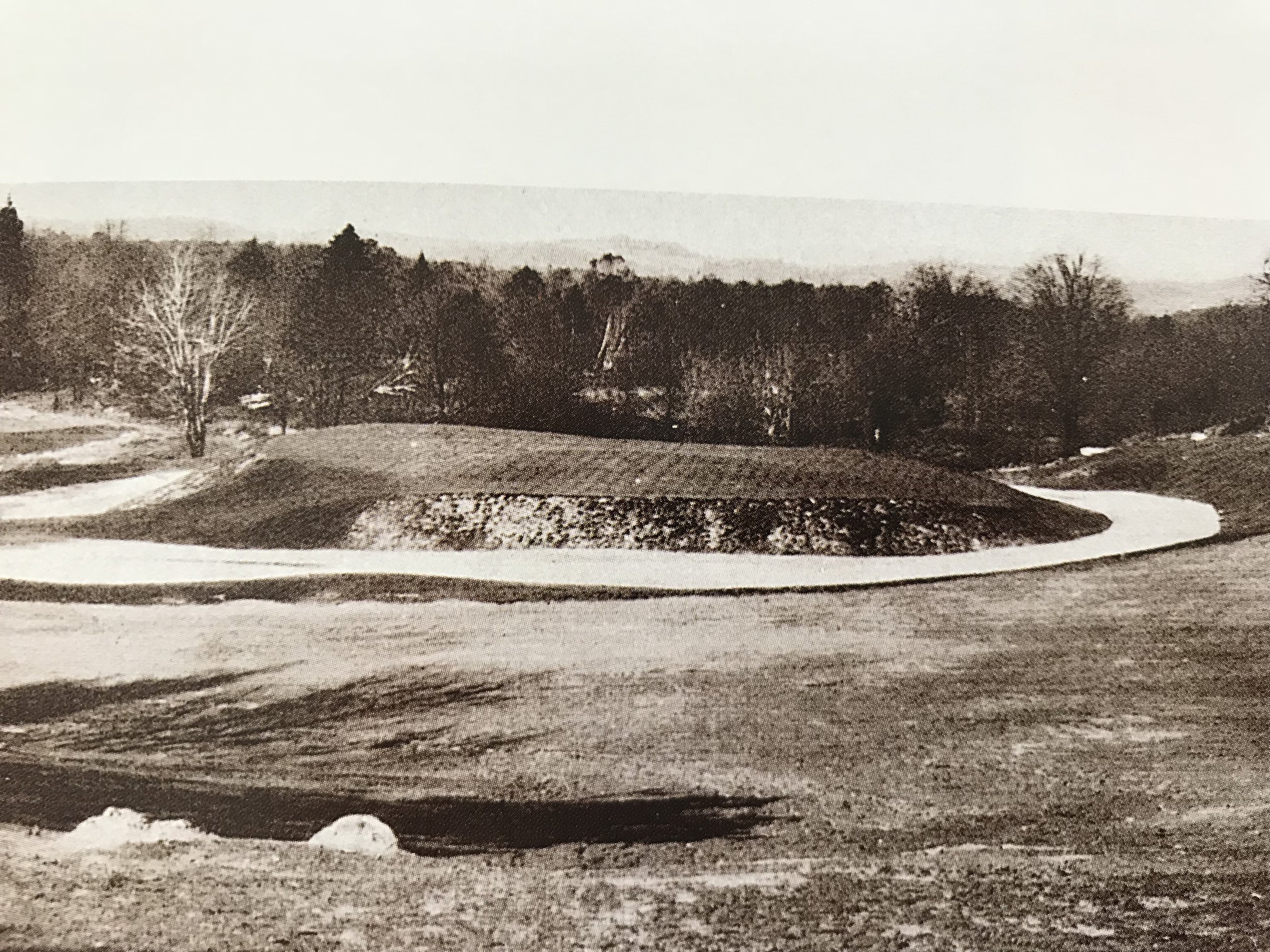Six-somes allowed. (photo credit: Toby Brearly)
This month is the 10 year anniversary of a life-changing trip to a golf course far away and lost in time: Askernish. To both reflect upon it as well as occupy my time during this pandemic crisis, I have been rolling out a multi-part series that explores my thoughts, emotions, and lessons learned from a legendary week on the links. Part 1 discusses the physical and mental act of getting there, while the second segment focuses on a fun exercise of routing a course on links land like it is 1891. This is Part 3 though, which talks about the existing golf course itself.
Day 3 (Continued)
We wrapped up our walk throughs of our routings in the mid afternoon and walked back in to the clubhouse (the actual one—not the old stone circle ruins) across the golf course. While on this walk, it was an obvious occurrence to many of us what we should do with the rest of our time on this clear, calm, blue-bird afternoon—play the golf course!
Besides going around a couple of the first few holes the night before, we had not yet had time to experience the full course, especially not the part that people travel far and wide to play—the middle stretch from 7-16. As it was a perfect, warm, and bizarrely calm and quiet afternoon, I absolutely couldn’t wait to get out and knock it around this natural golf ground that I had been thinking about for over a year.
People talk about how the course doesn’t really get started until the 7th hole and even go so far as to describe the early holes as “boring” or a “cow pasture.” While technically that second part is true, I really like the early holes, and the cow pasture part only enhances the experience, not detracts. What is also true is that this land in the early holes around the clubhouse was in fact more subdued, the reason being that much of it was bulldozed flat in the 1930s for landing planes at the onset of WWII. There was still much beauty it in though, especially in providing a contrast for what was to come.
We teed off out into the wide open field of short grass that is the par 5 first hole. Well, almost wide open. Occupying various parts of the fairway, about 20 cattle stood in the way, almost like fielders on a baseball diamond. It was a surreal experience to say the least hitting into them, next to them, and walking by. Again, there was almost no wind on this day and therefore almost no noise, outside of the occasional grunt or “moo!” For this, it goes right up there with the 1st and 9th of St Andrews for most memorable flat holes I have ever played.
The author heading straight into the opening hole’s main hazard: cattle. (photo credit: Toby Brearly)
When you get to the green and its large left-to-right kicker, you realize just how different and cool this whole thing is. For one, you have to carefully step over an electric shock wire that helps keep the cows and sheep off the greens. There are also the putting surfaces themselves, which have a variety of micro-undulation at a frequency, sharpness, and scale that I have never seen. A twenty foot putt could break 5 different ways. While some may think that is goofy or gimmicky, I think it is fun and also helps separate the better and more intuitive players from the rest.
The second hole is a cool little par 3 with the green tucked halfway around a small dune-form on the right. It also runs away from you and to the right, so a clever player can work it around. If you haven’t noticed yet, the ground game is prominent here.
The next few holes work in a little counter-clockwise loop before heading back to the clubhouse and eventually the bigger dunes. The 3rd hole is a little teaser dogleg. At 270 yards, the green is tempting for a longer hitter. Plenty of bad lies or even a lost ball await a miss though, and I would just as soon play safely out into the fairway and leave a wedge or a bump shot in.
4 turns back northward and is quite a cool hole with a wide fairway that gradually narrows and falls away on both sides at the pinch point. You want to take on that pinch point as much as you can though, as the green is one of the more difficult to hit with a number of small falloffs surrounding it.
We started out the round in separate groups, but by the 5th hole, we decided to all join up and play together. Despite slowing down the pace of play, this was a good idea and would turn out to make the post round discussions much livelier and on point.
The 5th hole itself is easier on your game and your eyes in comparison to the 4th. The tee shot is elevated on a dune, offering a great view across the simple plain of the opening holes as well as the Atlantic Ocean. The gentle dogleg curls to the left and finishes at a saddle-like green that also has a lot of back to front tilt. Even simpler holes like this are very compelling because of how strong the contouring is. Overall, the greens throughout the course have a very nice mix of both big and small contour. In a lot of places they fall away from the golfer. Keeping them at speeds of 8 or lower on the stimpmeter helps allow for this and makes the golf both more fun and more interesting. Listening to the most recent “Salon” on Derek Duncan’s Feed the Ball podcast, Bill Coore talked about modern green speeds and how they are “putting the cart before the horse.” In many cases of modern golf design, we have been letting green speeds dictate contour and shape on the greens instead of contour and shape dictating speed. How is that right? Why would you want to limit the one aspect of golf design that has the greatest impact on interest and over the smallest area? It does not make sense. Visiting and playing Askernish and its wild natural greens is a refreshing departure from that.
Another benefit and reason for the reduced speeds is that it also keeps from damaging the natural grass that makes up the greens. Remember, these were all just simply chewed or mowed down. No sodding, no seeding, no USGA sand and gravel profiles. This is the real thing.
The wonderful pastoral landscape around the clubhouse is a nice warmup for what is to come.
Back to the golf. Hole 6 was a long par 5 playing back along the simple ground that used to be a runway for prop planes. The green finished at a ridge and fell away, which was kind of clever if a little goofy compared to convention. Shots both long and short would have to be expertly judged to get close to the hole. If it was a long shot played along the ground, you would want to pace it to just barely crest the ridge and then trickle down over it. If it was a short shot played in the air, you would want to land it as closely to the ridge as possible and have it trickle down. Being too aggressive leaves a long but reasonably friendly recovery shot; being short means trying to accomplish the same thing again.
I use the past tense above because it was a clever green but has since moved closer to the beach edge as per Tom Doak’s suggestion. I haven’t seen the hole since that change, but I loosely remember the ground that the green would get moved to and think that it could be a good change that further engages the natural advantages of the course—the bright blue Atlantic Ocean the advantage in this case.
The approach and arrival at the 7th tee is the “A-ha!” moment of the round where everyone stops and goes silent with mouth agape, perhaps miming the word “wow” to themselves before going to reach for the camera. As Erik Anders Lang eloquently states upon his first sight of the hole, “It was like the acid kicked in and everything became colorful.” I can’t speak to the details of hallucinogenics, but, yeah, that sounds about right. All of a sudden, the land is completely different. Heaving dunes tumble as far as you can see while the ocean and white sand beach sit on the right with the mountainous Isle of Barra in the distance. The golf plays down through a large dune valley, winding its way about to the green as if it were truly designed. And I suppose it was, just not so by any men or machines. It is a magical golf hole and moment of experience.
Not only is the hole easy on the eyes, the golf itself also really works strategically. To get a visible angle into the green and avoid the sharp dune on the left, you need to take on the dune on the right. Longer hitters can clear it, while shorter hitters will have to try and get their ball to stop on the top of it where the fairway rides over. A running shot with of careful judgement and speed can then make its way up to the green, which falls from right to left and is guarded on the right by a sharp ridge (which was too sharp at the time but has since been softened by the talented hands of Eric Iverson). If trying to fly the ball onto the green though, you will want to avoid that right greenside ridge and come in more from the left, taking on the big, wooly dune in the process. That will help to hold the ball on the right-to-left tilting surface. No matter your game and skillset, the hole will hold your interest.
The big reveal at the 7th tee
Gotta play it off the beach
Of course, you can make all that above strategy moot and pop a huge fade out onto the beach, as some golfers do (see photo on right or above). One of the charms though of Askernish is there is no out of bounds. All land is in play, and that just connects you even more to the natural setting. So when I see my ball sitting 40 feet below on the beach, did you think I was going to play it? Hell yes I was going to play it! I don’t remember exactly what happened with the shot (which means I probably chunked it into even worse position), but I will always remember the fun and thrill of going down and trying it.
Hole 8 is a drivable (270 yard) par 4 high on the bluff with a crevasse intruding upon the right side of the fairway. The green, which is partially tucked behind a large dune on the left, is also guarded by a couple of the few formal bunkers on the course. While the bunkers on the other holes were natural sand scrapes and there were numerous small sandy spots throughout the course made by the rabbits, these bunkers were actually the result of cleaning up some rubbish areas. As the team cleared out the junk and were left with thin turf coverage, the most sensible thing was to formalize them into the course’s first bunkers. Off the tee, you will want to take on the intruding crevasse and trouble on the right, either clearing it or, if the wind is really strong, getting close to it. This will help get you a better angle into the green, as the bunkers and a large dune guard the left side of it.
Take on the trouble to the right to get an angle around the first bunkers on the golf course.
9 and 10 both continue outward along the seaside. 9 has a rising tee shot playing straight out toward the ocean, and those who play too carelessly may just find it. Like the 8th, the angle is also better playing close to the danger on the right, which I understand is much more in play now with the fairway being mowed closer to the bluff edge. That angle over there on the edge increases visibility and gives a longer look down a green that sits precariously on a very narrow shelf. Being short isn’t great, but being long is death. While the hole is only 341 yards, it is very demanding, even rating as the 3rd most difficult according to the handicap stroke index.
The 10th turns back inland a bit, but we aren’t ready to fully head back yet. It tees off marvelously near the ocean and out over a crevasse to the fairway beyond. The target is narrow but friendly in shape as balls hit out to the sides will feed back toward the middle. Blow one out to the right over the edge of the ridge though, and you might as well concede the hole to your partner. The green is also in kind of a saddle, but shots coming up a bit short will find themselves trickling back toward the golfer. All the holes are obviously natural, but this one really feels that way as the green is a true continuation of the fairway.
11 is a par 3 that gets a good amount of attention, and deservedly so. With views of the Atlantic, the long one-shotter to a tabletop green demands a good play over a deep valley. It’s a long, unsettling shot, and when I was there I found it a bit too penal as most short shots would either snag up in a small dune or catch a depression that fed into a steep road that would suck your ball down into a 40 foot deep pit. There is a bailout to the right, but it falls away and can kick your shot off over the bluff top. I think there has since been a little work to the approach on this hole, but I cannot fully comment on it without having seen it. With the length on shot and many needing to bounce the ball on though, it would be a beneficial spot to do some gentle alteration, at the very least cutting off the feeder into the road.
—
This might be a good place for some commentary on that topic: is alteration at Askernish a good thing? This was hotly debated during the week when we were there with the “new” course not even being a year old yet. It was so much a debate that I also knew my former (though not yet for another year and a half) boss Tom Doak was involved with some additional consulting.
Obviously, the course had been “found” and, outside of some small shaping work for the tees, simply mowed down to playable golf height. It was completely natural and unaltered, and that made for both an intriguing story and great study into the origins of golf before land was alter-able. But there were admittedly some places on the course that were a bit rough and sharp and didn’t work as well you would hope for the types of golf shots you would want to play in a given situation. The 6th, with its green set away from the land edge, and the 7th, with its very sharp greenside ridge, have already been discussed. I just mentioned the 11th, and later on I will talk about the 16th, which was maybe the fiercest ongoing debate of all. The common theme among all of these holes (outside of the 6th) is that they have/had very sharp, dramatic features that impede ground game shots, the ground being too steep or rugged for anything to run through without a very lucky bounce.
I have to state here that I LOVE the romanticism of the untouched ground story, and there is so much there that all factions of the industry can learn from it. I have to also agree with the suggestions eventually made by Doak to soften a few things. Askernish is not just a cool place and cool story. It’s also a really damn good golf course. And if you can make just a few small tweaks, keeping the ground generally in place and just making it more amenable to a ball rolling through it, you can make it that much better. The key is having a very soft hand, deeply understanding the types of contours found throughout the course, and re-turfing with the same native grass. Fortunately, all of that was in place with Eric Iverson shaping and plenty of sods available.
Because it was to be done like this in the right way, I was in favor of the tweaks, despite it maybe ruining a little bit of the purity of the story. It is all for the better of the golf experience though. It certainly isn’t change for the sake of change, which would be disastrous on such sacred ground. A part of me also thinks that Old Tom very well might have done the same things—shovel, spade, and wheelbarrow in tow. After all, he altered many spots out on The Old Course, including the 18th green where he built up the entire “flat table-land.” Who is to say he wouldn’t have done the same to Askernish? When put this way, maybe it isn’t as much of a deviation from the story as I first thought…
—
Getting back to the golf and the 12th hole, which is probably my favorite on the whole course. Many of the holes have a “choose your adventure” element to them, especially when the grass is chewed down by the animals like it was during our visit. The 12th though is very much that, moreso than any other hole out here. The long, downhill par 5 tees off from the edge of the sand bluff and plays over perhaps the best golfing ground on the whole course before finishing beautifully at the low-land edge of the machair, the reflective water of the nearby lochs shimmering in the distance. It should be noted also that these are the same type of golf-scale dunes talked about in Part 2 and where our 2nd and 3rd holes were routed.
I am a huge fan of the way this hole experiences every landscape type found throughout the course on one single hole. You have the ocean and white sand beach to your back. The most dramatic dunes are still there off to the left while you play over the intermediate ones through the hole. The mountains and distant Barra are still present, and then you finish on a wonderful green slightly perched over the flattest lowest section of the machair, which bleeds off into moorland and eventually the water of the lochs within it. The landscape value of the hole is incredible, but the golf is fantastic too.
The 12th green sits in a stunning spot that is a remarkable contrast from where the hole started. Photo taken from and courtesy of Askernish Golf Club
At the tee, you have your first choice on the hole. Try for the longer carry and narrower fairway out to the left, or play more safely to the shorter and wider one on the right. If you bail right, you are left with a blind shot over a big ridge and another decision to make: play a shot of about 150-170 yards to the left fairway but have a tougher angle to the green, play the same yardage shot straightaway to leave a little bit better angle but still 160 to the hole, or rip a 3 wood and hope to find the approach fairway about 210-230 yards away and have 100 or less to the hole. If you go left off the tee, your options are similar, but finding the approach fairway is much easier as well as visible. Brave, long hitters may even try to have a crack at the green, but because of a fronting ridge and a greenside bunker (this one wholly natural) on the left, it is a very tough shot to pull off. Overall, it is a brilliant, fun, rollicking hole and one you can play a different way each time you tee it up.
13 is bit of a breather and a nice little connector hole with more of the wonderful views out across the machair on the right. Its reverse-cant fairway wraps to the left uphill to a tucked green that has some surprising danger at its back. That danger is a sharp falloff and a return to the dramatic dunesland, which the par 3 14th plays right into the teeth of. The dangerous, mid-length par one-shotter plays across a valley to a little tabletop green just sitting there beautifully. Seeing this flat oasis with falloffs all around and knowing it was unaltered makes similar versions you see on other links courses that much more believable.
The 14th is a wonderful and challenging par 3 that was awaiting perfectly for the team to claim as a hole.
15 is a shorter par 4 playing through similarly choppy ground. A pinching, crowned fairway makes it effectively play longer though, with the smart play leaving about a 150 yard shot for the second. Originally Martin and Gordon were looking at a par 5 hole with a green further along over a big ridge, but they instead settled on something much shorter and what is my favorite green on the whole course—a shallow little halfpipe that is a blast hitting shots into. The fronting slopes are highest on the left and right, and in between them is a bit of a downhill halfpipe running perpendicular to the green that can be used to help funnel shots through. Even though the shot into the green might only require a higher lofter club for some, it is perhaps a safer play to land it short and bounce it into the bowl. Trying to fly it onto the green and coming up just shy could see you catch the downslope and have your ball rocket on through the green and into the long grass at the back. This is one of those greens though where the recovery shots are so fun, it is almost more enjoyable to miss it on the approach.
Above gallery: the awesome 15th green as seen from the front (left) and right (right)
On to 16 and the controversy mentioned before. The par 4 doglegs slightly right and finishes at a pretty extreme elevated green. The approach to it is very steep and wall-like, which kills just about any sort of running shot. At the top of the wall-like ridge sits a very shallow shelf where, when we played it, the hole was often placed. Beyond the shelf, it falls very steeply in undulating fashion.
As we debated the hole back in the clubhouse, I could see its merits as a true “adventure” type hole and how it functions for match play, but in the end I just thought that trying to land on the top section crossed the threshold of deft skill into daft luck. I said that as well even after getting a 4 iron to stick up there (it required a perfect, speed killing bounce just off the top of the wall in front of the green). Indeed, Eric Iverson and Tom Doak, along with Martin Ebert, did some work on it shortly thereafter, moving the green down to more of a full time position in the back area below and making that more receptive. All the comments I have heard from everyone since have been glowing, and I am quite interested to see how it now plays.
Looking back over the 16th green with the 9th fairway in the distance. The green for 16 is now located in the low section closer to this perspective.
I can’t really speak much to the par 3 17th, as it has been moved to a different location from a tough-to-get-close high spot on the right down to a longer but lower and more protected green on the left. It’s another change I would like to see and experience.
Returning home on the par 5 18th is also a return to the simpler ground surrounding the clubhouse, and some may find it to be something of a let down compared to the previous stretch. I disagree though. For one, the views across the broad landscape to the right and straight ahead are beautiful. It also plays around an old cattle pen, its earthen cops still prominent and intruding upon play to the left on the inside of the dogleg. The approach to the large finishing green is perfect for a bouncing shot, the land much simpler yet still slightly tilted and containing plenty of wrinkle to keep your attention, especially on the green itself. After the preceding long stretch of holes meandering the massive dunes, I felt this open, subdued finish to be a nice, relaxing sort of come-down to complete the round. Just as it started slow and easy, it now does the same over the very ground you began upon, the round tying together full circle.
The walk back to the clubhouse is actually a bit long, but it is perfect. Strolling along this same, grazed-down ground, it gives the golfer plenty of time to recall what they just experienced as well as soak up the landscape upon them. It makes me realize that many rounds of golf end too abruptly. All of a sudden you walk off the last green and find yourself immediately in the clubhouse or worse yet, the parking lot changing your shoes. The discord from one space, both mentally and physically, is jarring. Just as we allow ourselves a moment to digest after a fine meal, we could use more the lengthy, reflective post-round walks after experiencing a fine course like that at Askernish.
We could use more contemplative walks like this after the 18th. Of course, if you aren’t of that mindset and easily get bored, just drop a ball and chip your way back.
———
As we headed back in and recalled our round, we noticed some smoke streaking across the sky coming from some nearby hills. It continued to grow, and the trail of it shifted to obscure the sun for the first time in hours, turning it a deep pink/red behind the streaky black smoke. It was rather stunning.
We also asked Paul to help us on a grocery run. We needed food (and beverages). At the Co-op (a common small-scale Scottish grocery chain), we loaded up on supplies for that night as well the next few. Some guys planned to cook a dinner together. I don’t know if it was subliminal messaging provided by the many sheep or my own penchant, either real or imagined, for living locally off the land, but I went rogue from the group and got myself a little leg of lamb to roast.
In that same vein, the other American, Price, kept asking the club members to put him in touch with a local fish monger to get some fresh shellfish from the nearby waters. On night two, still no luck or word despite being told they’d be able to come up with something.
My perfectly medium-rare lamb rather disgusted the Brits, who for some reason like their meat gray and dry. It was perfect for my tastes though and would provide some good leftovers for the following night. We wrapped up our meals and walked outside to bask in the twilight. As we did, we noticed the smoke was more intense. As we turned around toward the mountains, we also noticed that the fire was now visible in the waning light, and it was impressive.
The fire from the mountains was calling, and we must go…
With some wine from dinner and a few pints of Tennant’s in us, we got the wise idea to take a walk and chase the fire, not knowing whether it was a controlled burn or a wildfire. Remember that youthful idiocy I described at the end of Part 1? Turns out two days was not enough time to grow out of it. The walk started out with 3 or 4 of us, dressed in warmer clothes and armed with a few more silver cans for the walk. I also brought my camera, even though I knew capturing shots without a tripod was going to be tough.
As we walked out to the island’s main road, a paved one-lane highway, we realized this thing was actually some distance away. At that point it was close to full darkness, and a couple of the others bailed, leaving just Toby and myself. We were committed and determined at that point. As we walked along, we gained ground but not nearly at the pace we would have thought. Eventually, we realized the fire was burning away from us and that this truly was a game of chasing. Still, despite our beers running out some 20 minutes ago or so, we decided we were too close not to press on and reach it.
And reach it we did. The flashing lights from the fire trucks spun through the peat-smelling smoke. The firefighters were scattered all about, but there was no sense of urgency in their movements. This was a controlled burn under control, and it was nearing the end of its run. Perhaps a bit disappointed but still happy with taking on the adventure, we headed back down the one lane highway toward the house, tired and weary-eyed. As it was approaching 1 AM with still a ways to go, I stuck out my thumb to hitchhike for the first time in my life. If it weren’t for the overwhelming friendliness of the islanders, I might not have done it, but it seemed well worth the extra 30-40 minutes of sleep we’d get. Needless to say the two cars we saw on the whole walk did not stop for us, but that was all fine. Walking back the whole way gave a sense of completeness to the journey.
Once again, I had stayed up way too late in order to gain a new experience, and while it was exhausting it was also worth it. After all, you don’t write on your website about the early bed time and good night sleep you got ten years prior. You write about the time you walked 4 miles down the road in pitch black on a remote foreign island to chase down a fire that may or may not be controlled.
Morning came, and opening the eyes and standing up out of bed were as hard as could be imagined. There were very few things that could get me up and moving with motivation that morning, but our activity for that day was certainly one of them: building a links bunker using the methods of Old Tom Morris. I couldn’t wait to get back out there.
Part 4 will get into some nitty gritty bunker work and should appear later this week. Stay tuned, and thanks for reading!




